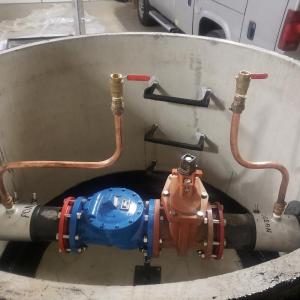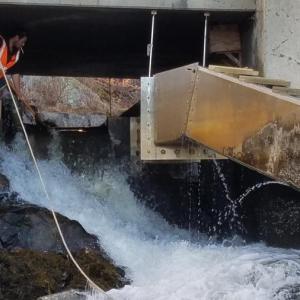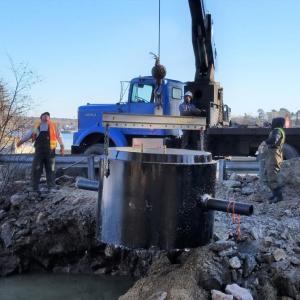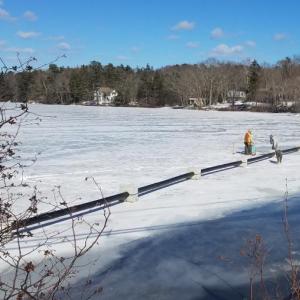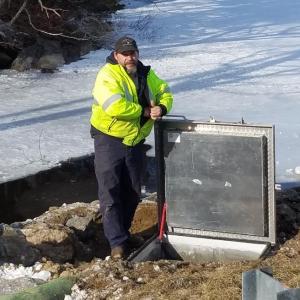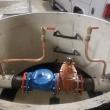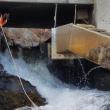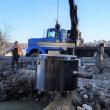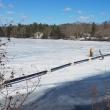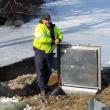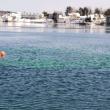At long last, West Harbor Pond siphon up and running
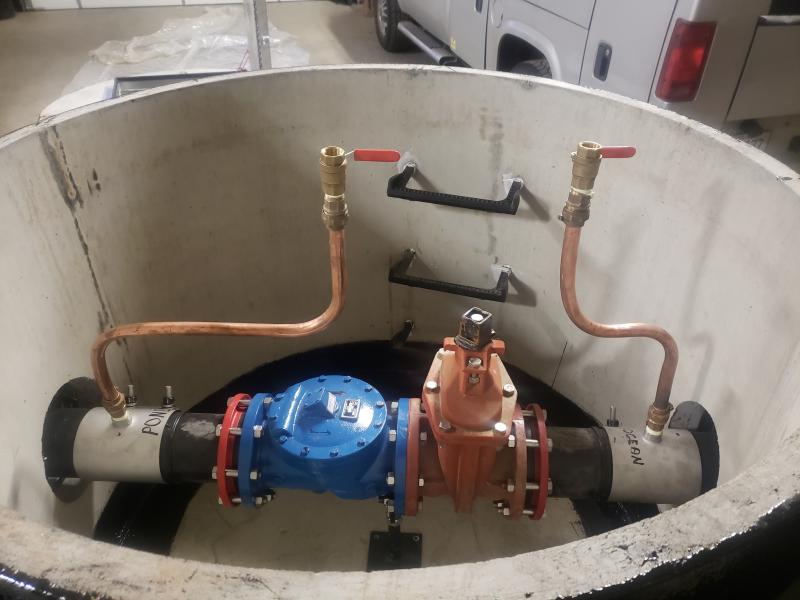 Controls for the siphon, showing a check valve (blue); a large ball valve (orange) and two small ball valves. Merritt Blakeslee photo
Controls for the siphon, showing a check valve (blue); a large ball valve (orange) and two small ball valves. Merritt Blakeslee photo
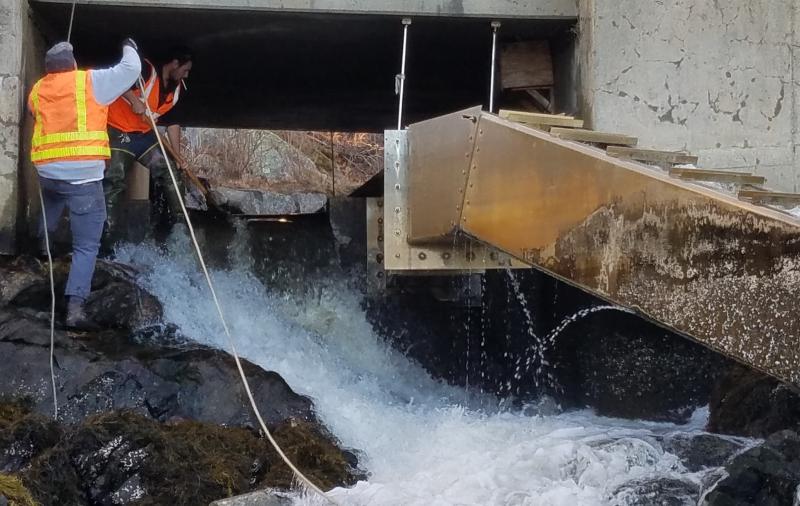 Kipp Farrin, left, and Josh Cook thread the siphon pipe through the dam in the box culvert. Merritt Blakeslee photo
Kipp Farrin, left, and Josh Cook thread the siphon pipe through the dam in the box culvert. Merritt Blakeslee photo
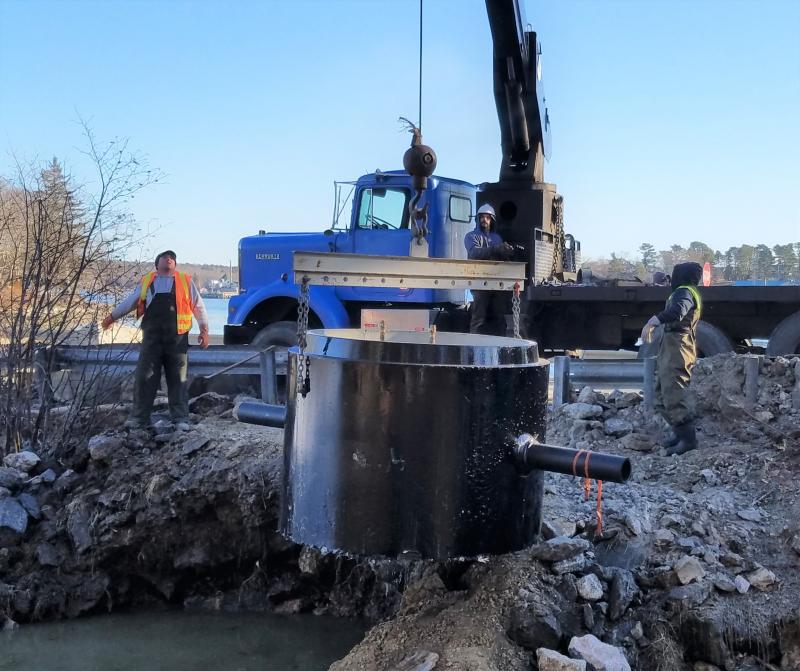 December 13, 2018: A crane lowers a manhole cylinder into place. Merritt Blakeslee photo
December 13, 2018: A crane lowers a manhole cylinder into place. Merritt Blakeslee photo
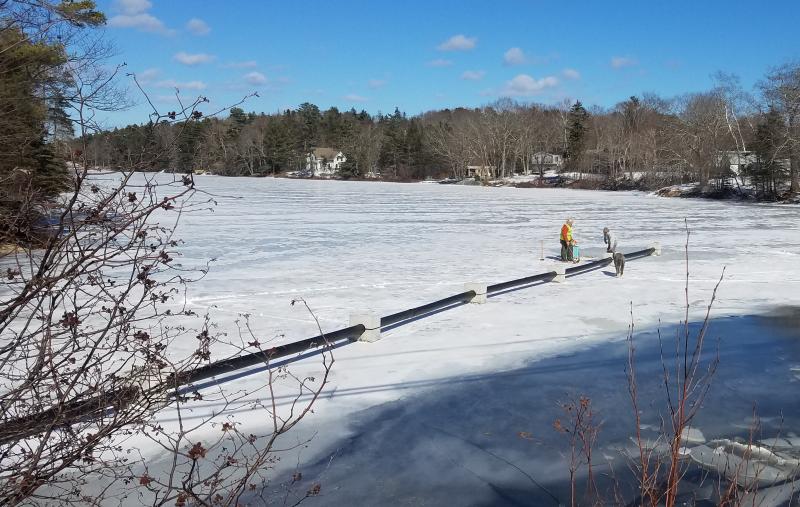 Pond-side pipe is laid out on the surface of the pond as Mike Doyen and Pat Farrin, assisted by Reef, determine the proper location for siphon intake. Merritt Blakeslee photo
Pond-side pipe is laid out on the surface of the pond as Mike Doyen and Pat Farrin, assisted by Reef, determine the proper location for siphon intake. Merritt Blakeslee photo
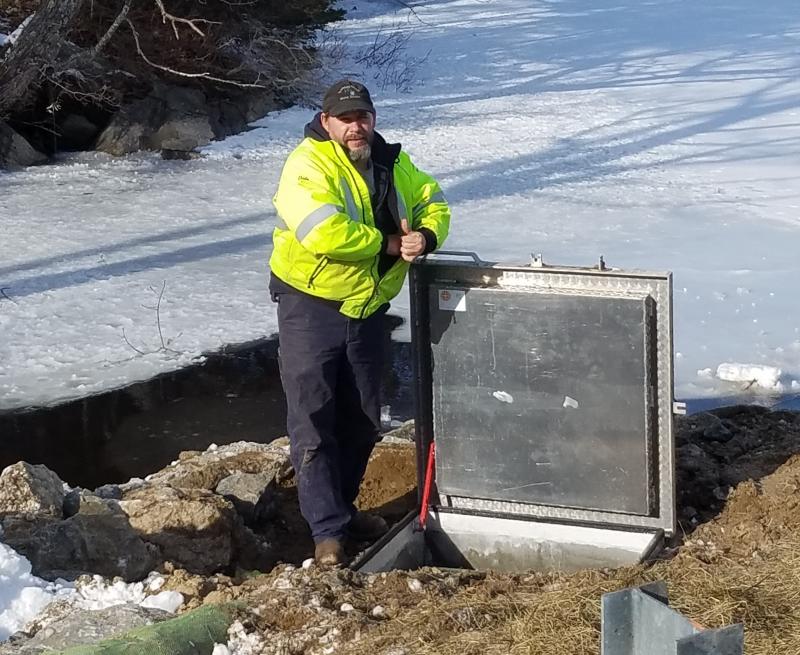 Dale Harmon, operations manager of Boothbay Region Water District, beside the manhole cylinder he and his crew assembled, after installation. Merritt Blakeslee photo
Dale Harmon, operations manager of Boothbay Region Water District, beside the manhole cylinder he and his crew assembled, after installation. Merritt Blakeslee photo
 And here it is, the culmination of five years of hard work as green dye filters through the siphon into the ocean. Merritt Blakeslee photo
And here it is, the culmination of five years of hard work as green dye filters through the siphon into the ocean. Merritt Blakeslee photo
 Controls for the siphon, showing a check valve (blue); a large ball valve (orange) and two small ball valves. Merritt Blakeslee photo
Controls for the siphon, showing a check valve (blue); a large ball valve (orange) and two small ball valves. Merritt Blakeslee photo
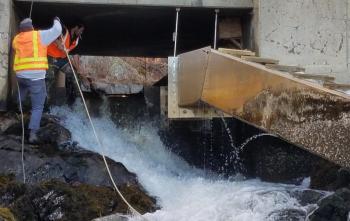 Kipp Farrin, left, and Josh Cook thread the siphon pipe through the dam in the box culvert. Merritt Blakeslee photo
Kipp Farrin, left, and Josh Cook thread the siphon pipe through the dam in the box culvert. Merritt Blakeslee photo
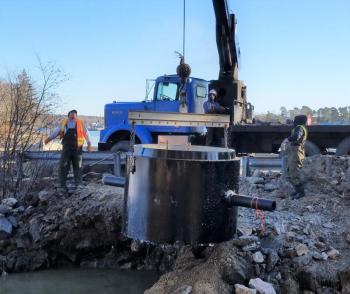 December 13, 2018: A crane lowers a manhole cylinder into place. Merritt Blakeslee photo
December 13, 2018: A crane lowers a manhole cylinder into place. Merritt Blakeslee photo
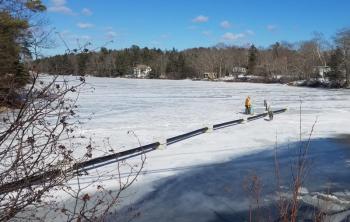 Pond-side pipe is laid out on the surface of the pond as Mike Doyen and Pat Farrin, assisted by Reef, determine the proper location for siphon intake. Merritt Blakeslee photo
Pond-side pipe is laid out on the surface of the pond as Mike Doyen and Pat Farrin, assisted by Reef, determine the proper location for siphon intake. Merritt Blakeslee photo
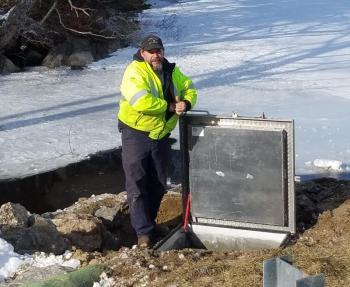 Dale Harmon, operations manager of Boothbay Region Water District, beside the manhole cylinder he and his crew assembled, after installation. Merritt Blakeslee photo
Dale Harmon, operations manager of Boothbay Region Water District, beside the manhole cylinder he and his crew assembled, after installation. Merritt Blakeslee photo
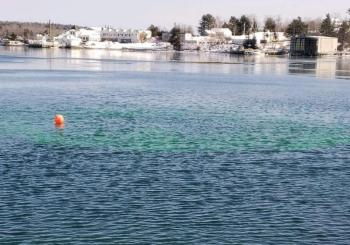 And here it is, the culmination of five years of hard work as green dye filters through the siphon into the ocean. Merritt Blakeslee photo
And here it is, the culmination of five years of hard work as green dye filters through the siphon into the ocean. Merritt Blakeslee photo
West Harbor Pond was created in 1880 when a dam was constructed across the mouth of Campbell Creek to create a freshwater pond for the production of natural ice for sale to the large urban centers of the Eastern Seaboard. Capt. E.D. Haley, who designed the dam, installed a passive siphon to evacuate sea water trapped behind the dam at the time of construction. This siphon continued to purge the sea water that entered the pond at extreme high tides until about 2008, when the old cast iron pipe finally failed.
Because it is heavier than fresh water, salt water sinks to the bottom and, if not removed, prevents the seasonal turnover and reoxygenation of the pond. Without seasonal turnover, the lower half of West Harbor Pond has become a dead zone for aquatic life. In 2014, once it was understood how severely the broken siphon was degrading the pond's water quality, the West Harbor Pond Watershed Association began seeking funds to repair or replace the old siphon. In June 2017, the Maine Coastal Program of the Department of Agriculture, Forestry, and Conservation awarded the WHPWA and Boothbay Harbor a $15,000 Coastal Communities Grant, enabling the WHPWA to hire Dirigo Engineering to prepare plans for a replacement siphon. In June 2018, with the Dirigo plans in hand, the WHPWA launched a Campaign to Save West Harbor Pond and, within three months, had raised the funds to pay for a new siphon.
The new siphon consists of three parts: a 100-foot piece of six-inch plastic seasonal water pipe running from the deepest point at the lower end of the pond to a manhole cylinder in the pond next to the box culvert at the west end of the Highway 27 causeway; the manhole cylinder, which houses the controls for the siphon; and a 150-foot piece of six-inch pipe running from the manhole cylinder through the box culvert and out into the harbor.
Last fall, the Boothbay Region Water District installed the control valves in the manhole cylinder and fused together lengths of 6-inch seasonal water pipe (familiar to Boothbay and Boothbay Harbor residents} to create the two lengths of siphon pipe that together constitute the replacement siphon. The Water District donated the pipe, which had been removed from Southport when a section of year-round water service was installed, along with the labor to fuse the pipe.
In December, Pat Farrin & Sons began work to install the new West Harbor Pond siphon, which runs through the box culvert. Farrin & Sons cored a hole through the small concrete dam in the box culvert to allow the siphon pipe to pass from the pond to West Harbor. Installation began in bitterly cold weather as Farrin and his crew lowered the harbor-side siphon pipe into place and then painstakingly threaded it through the hole in the small dam in the box culvert, under the Highway 27 causeway, and out onto the pond side. The crew then installed 300-pound concrete weights at 8-foot intervals to anchor the pipe to the bottom of the harbor.
Installing the manhole cylinder at the necessary depth required the crew to remove three feet of ledge. After the cylinder was set in place and the harbor-side siphon pipe was hooked up to it, work on the siphon was suspended during January and February due to weather and the Department of Transportation’s work shoring up the outer face of the Highway 27 causeway. In the first week of March, Farrin and his crew hauled the pond-side siphon pipe out onto the ice, weights already attached, and, using chainsaws to cut away the ice, dropped it into position, and connected the pond-side siphon pipe to the manhole cylinder, completing the installation of the siphon. That afternoon, Dale Harmon of the Water District put dye into the siphon at the manhole cylinder, hoping to see it appear at the harbor-side outlet. By the end of the day, no dye had appeared, a sign that portions of the siphon were still frozen. So on March 8, Harmon placed a heater in the manhole cylinder to melt any ice obstructing the siphon mechanism, especially the check valve. Using a large air compressor, his crew then blew air first through the pond-side pipe, then through the harbor-side pipe, removing any remaining ice. Harmon put more dye in the siphon, and at about 2 p.m., a green bloom of dye briefly appeared at the surface of the harbor before dissipating, indicating the siphon was, after an effort that stretched over five years, finally working.
For a gallery of photographs and a more detailed narrative of the siphon installation, please visit https://www.westharborpond.org/
Event Date
Address
United States

